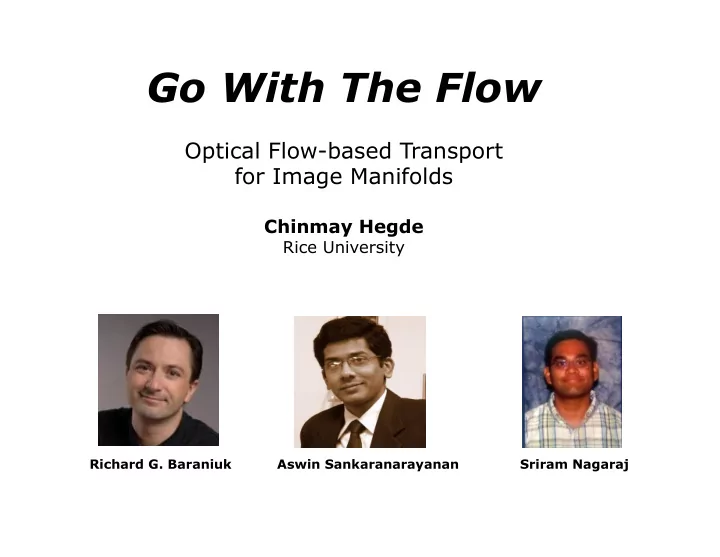

Go With The Flow Optical Flow-based Transport for Image Manifolds Chinmay Hegde Rice University Richard G. Baraniuk Aswin Sankaranarayanan Sriram Nagaraj
Sensor Data Deluge
Concise Models • Our interest in this talk: Ensembles of articulating images – translations of an object ! : x-offset and y-offset – wedgelets ! : orientation and offset – rotations of a 3D object ! : pitch, roll, yaw • Image articulation manifold
Image Articulation Manifold • N -pixel images: • K -dimensional articulation space • Then is a K -dimensional “image articulation manifold” ( IAM ) • Submanifold of the ambient space
Image Articulation Manifold • N -pixel images: • Local isometry : image distance parameter space distance • Linear tangent spaces are close approximation locally articulation parameter space
Image Articulation Manifold • N -pixel images: • Local isometry: image distance parameter space distance • Linear tangent spaces are close approximation locally articulation parameter space
Theory/Practice Disconnect • Practical image manifolds are not smooth • If images have sharp edges, then manifold is everywhere non-differentiable articulation parameter space [Donoho, Grimes,2003]
Theory/Practice Disconnect – 1 • Lack of isometry • Local image distance on manifold should be proportional to articulation distance in parameter space • But true only in toy examples • Result: poor performance in classification, estimation, tracking, learning, … articulation parameter space
Theory/Practice Disconnect – 2 • Lack of local linearity • Local image neighborhoods assumed to form a linear tangent subspace on manifold • But true only for extremely small neighborhoods • Result: cross-fading when synthesizing images that should lie on manifold Input Input Image Image Linear path Geodesic
A New Model for Image Manifolds Key Idea: model the IAM in terms of Transport operators For example:
Optical Flow • Given two images I 1 and I 2 , we seek a displacement vector field f(x, y) = [ u(x, y), v(x, y) ] such that • Linearized brightness constancy
Optical Flow Manifold (OFM) • Consider a reference image OFM at and a K -dimensional articulation • Collect optical flows from to all images reachable by a IAM K -dimensional articulation. Call this the optical flow manifold (OFM) • Provides a transport operator to propagate along manifold Articulations
OFM: Example Reference Image
OFM: Properties OFM at • Theorem: Collection of OFs (OFM) is a smooth K -dimensional submanifold of [S,H,N,B,2011] IAM • Theorem : OFM is isometric to Euclidean space for a large class of IAMs [S,H,N,B,2011] Articulations
OFM = ‘Nonlinear’ Tangent Space Tangent space at OFM at IAM IAM Articulations Articulations
Input Image Input Image IAM Linear path Geodesic OFM
App 1: Image Synthesis
App 2: Manifold Learning 2D rotations Embedding of OFM Reference image
App 2: Manifold Learning Data 196 images of two bears moving linearly and independently Task Find low-dimensional embedding IAM OFM
App 3: Karcher Mean Estimation • Point on the manifold such that the sum of squared geodesic distances to every other point is minimized • Important concept in nonlinear data modeling, compression, shape analysis [Srivastava et al] 10 images from an IAM ground truth KM linear KM OFM KM
Summary • Manifolds: concise model for many image processing problems involving image collections and multiple sensors/viewpoints • But practical image manifolds are non-differentiable – manifold-based algorithms have not lived up to their promise • Optical flow manifolds (OFMs) – smooth even when IAM is not – OFM ~ nonlinear tangent space – support accurate image synthesis, learning, charting, …
Blank Slide
Open Questions • Our treatment is specific to image manifolds under brightness constancy • What are the natural transport operators for other data manifolds ?
Optical Flow two-image 2 nd image predicted sequence optical flow from 1 st via OF (Figures from Ce Liu ’ s optical flow page and ASIFT results page)
Limitations • Brightness constancy – Optical flow is no longer meaningful • Occlusion – Undefined pixel flow in theory, arbitrary flow estimates in practice – Heuristics to deal with it • Changing backgrounds etc. – Transport operator assumption too strict – Sparse correspondences ?
Pairwise distances and embedding
Occlusion • Detect occlusion using forward-backward flow reasoning Occluded • Remove occluded pixel computations • Heuristic --- formal occlusion handling is hard
History of Optical Flow • Dark ages (<1985) – special cases solved – LBC an under-determined set of linear equations • Horn and Schunk (1985) – Regularization term: smoothness prior on the flow • Brox et al (2005) – shows that linearization of brightness constancy (BC) is a bad assumption – develops optimization framework to handle BC directly • Brox et al (2010), Black et al (2010), Liu et al (2010) – practical systems with reliable code
Recommend
More recommend